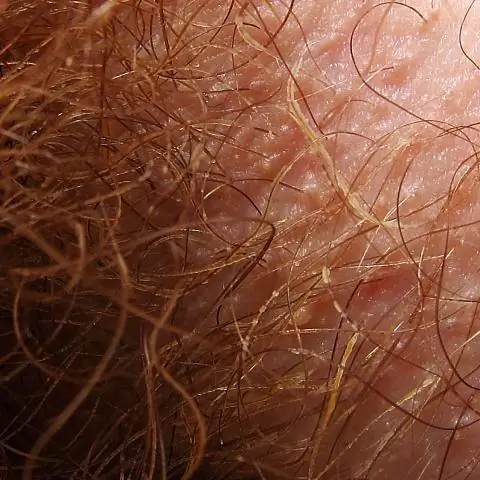
Table of contents:
- How and what to wash different types of paints from clothes and other items
- Are all paints removed the same
- How to remove different types of paint from clothes
- If paint gets on the sofa or carpet
- How to wash paint from linoleum
- Removing paint from plastic
- How to scrub wallpaper stains
- Paint stains on hands
- Author Bailey Albertson [email protected].
- Public 2023-12-17 12:53.
- Last modified 2025-01-23 12:41.
How and what to wash different types of paints from clothes and other items

You can get dirty with paint while standing at the easel, sitting on a painted bench, leaning against the fence. Stains cannot be avoided even at home, especially when young artists decided to get acquainted with this multi-colored substance for the first time. Sadly looking at the surfaces and clothes hopelessly stained with paint, many housewives plunge headlong into despair. However, coping with this problem is not at all difficult using simple and affordable means.
Content
- 1 Are all inks removed the same
-
2 How to remove different types of paint from clothes
- 2.1 How to remove oil paint stains
- 2.2 How is gouache, watercolor, tempera removed from clothing
- 2.3 Removal of acrylic and latex paint
- 2.4 Removing water-based paint with alcohol
- 2.5 How to remove an alkyd enamel stain
- 2.6 How to remove traces of paint from clothes - video
-
3 If paint gets on the sofa or carpet
-
3.1 Cleaning acrylic paint stains
3.1.1 How to remove dried acrylic paint
- 3.2 Instructions for cleaning latex and emulsion paints from carpets
- 3.3 Purification of oil paint with turpentine
-
- 4 How to wash paint from linoleum
- 5 Removing paint from plastic
- 6 How to wipe away stains on wallpaper
-
7 Spots of paint on hands
7.1 How to wash your hands from paint - video
Are all paints removed the same
First of all, you need to find out what kind of paint was the source of the problem. If the stain is very recent, it will be much easier to remove. If the paint dissolves in water, laundry soap can handle it. Currently, there are a large number of different paints that differ significantly in composition. Compared to watercolors or gouache, which can be removed easily and simply, oil and acrylic paints will take longer.

Watercolors can be removed with soap and water
Holi paints used during fun festivals are also not easy to wash. They are made on the basis of natural dyes, which are very difficult to wash.

Holi paints are not always washed off
How to remove different types of paint from clothes
Dye stains on clothing are the most troublesome. Professional dry cleaning services may not be affordable for everyone. You can cope with this problem yourself using the following recommendations.
How to remove oil paint stains
Use vegetable oil to remove fresh stains.
- Apply it to the stain using a cotton swab.
- Rub the surface lightly.
- After the oil has diluted the paint, get rid of the grease stain using salt, gasoline, acetone.
You can remove a greasy oil stain with starch.
- Apply the substance to the contamination.
- Place a blank sheet of paper on top and iron with an iron.
Gasoline intended for refueling lighters, acetone or turpentine will also help to cope with a fresh stain. Treat the fabric with any of these substances. Then wash your clothes. It is not recommended to use these products to remove paint from delicate fabrics.
Sometimes the stain is washed off with liquid soap and water at a low temperature.
- Pour liquid soap over the dirt and let it saturate the fabric well.
- Use a clean rag to gently wipe off the stain.

Liquid soap will remove fresh paint stains from fabric
If the stain is not fresh, proceed in stages.
- Remove any remaining paint with a knife.
- Soften the stain with any solvent (acetone, turpentine, gasoline, vegetable oil) or a stain remover. This process usually takes about 30 minutes.
- Rub the stain thoroughly with a sponge or thick cloth.
- Do your regular wash.
The method is highly effective. But if clothes made from synthetic fibers, wool, cashmere and leather are damaged by oil paint, it is not safe to use solvents. The same sunflower oil will help remove contamination.
How to remove gouache, watercolor, tempera from clothes
Even if the watercolors, gouache have dried on the fabric surface, an ordinary machine wash will not leave a trace of them, as they dissolve well in water.

Laundry soap easily removes fresh paint stains
Tempera is removed with dishwashing liquid.
- Apply the detergent to the stain.
- Rub it lightly.
- Rinse clothing in clean water and wash if necessary.
Add a few drops of liquid soap to the tamper before starting work to avoid difficult contamination. This will make it easier and faster to remove the stain in the future, using only soap and water.

Fairy Dishwashing Liquid will dissolve the fats present in the tempera
Removing acrylic and latex paint
Fresh stains from these paints can be easily removed: hold the clothes turned inside out in cold water, squeeze well and wash in the machine at a temperature of 30 ° C, setting the longest setting. If traces remain, proceed as follows.
- Sprinkle detergent over the dirt.
- Armed with a toothbrush, scrub the contaminated area.
- Rinse the stain with hot water.
- Machine wash at high temperature.
If that doesn't work, use a stain remover.

When removing acrylic paint from clothes, you cannot do without a washing machine
Removing water-based paint with alcohol
Regular alcohol will help dissolve such contaminants. The method is very effective and does not require special expenses.
- Apply it to the fabric surface with a swab.
- Rub the stain lightly.
- Do your normal wash.
If you don't have alcohol on hand, you can soak the item in soapy water and hand wash.

Ethyl alcohol successfully copes with water-based paint
How to remove alkyd enamel stain
Use White Spirit:
- Place a clean cloth under the affected area.
- Apply the substance to the stain, rub it lightly using a cotton swab.
- Remove stain and wash clothing with laundry soap.

White spirit is a versatile solvent that can remove paint stains
Denim fabric, characterized by high strength, tolerates processing well with any of the listed compounds. The methods described are also effective in removing holi paints.
How to remove traces of paint from clothes - video
If paint gets on the sofa or carpet
If paint accidentally spills onto a sofa or carpet, the first step is to place some paper towels or paper towels around the stain to prevent it from spreading over the surface. Use a towel to gently blot the stain itself. Then, depending on the type of paint, you can use different methods.
Cleaning acrylic paint stains
- Cover the stained area with a glycerin napkin.
- Dissolve the stain with acetone or nail polish remover.
- Use a soapy solution to wipe off any residue using a clean rag or sponge, without dampening the furniture or carpet.
- Dry the wet area with a dry towel.
- Vacuum your carpet or sofa.

Nail polish remover will help remove acrylic paint from upholstered furniture
How to remove dried acrylic paint
- Use a knife to scrape it off the surface of your sofa or carpet.
- Spray the stain with WD-40 spray.
- Remove the stain after 20 minutes. You may need to use a knife.
- Wash the treated area with soapy water and dry.

WD-40 Thinner will remove dried acrylic paint
Instructions for cleaning carpets of latex and emulsion paints
To remove latex paint stains:
- Blot the stain with a dry cloth.
- Moisten it with water while wiping gently from the edges to the middle.
- Rub the dirt with a soft bristle brush and soap solution.
To remove emulsion paint, do the following:
- Blot the stain with a dry cloth.
- Place a rag soaked in apple cider vinegar over the dirt, but don't rub.
- When the paint has soaked into the rag, turn it over with the clean side down. Try to remove the stain by changing the vinegar-soaked rags as needed.
- Wash off any remaining dirt with soapy water.
- Dry the surface to be treated.

Apple cider vinegar can dissolve emulsion paint
Cleaning oil paint with turpentine
- Blot the stain with a clean paper towel.
- Apply turpentine to it. When the contamination dissolves, remove it.
- Wash off remaining solvent with refined gasoline.
- Wash the area to be treated with soapy water and dry.

Oil paint is removed from clothes with turpentine
How to wash paint from linoleum
If in the process of work the paint gets on the linoleum, do not despair.
- If it is a water-based suspension, simply wipe it off with a damp cloth.
- Remove the oil paint with a napkin, then apply sunflower oil to the stain and wash off the dirt with any cleaning agent.
- If the nature of the paint is unknown, use a solvent - acetone, white spirit, thinner 646. Pre-test on an inconspicuous area of the product.

Any solvent, for example, White Spirit, will help get rid of paint stains on linoleum.
Removing paint from plastic
Powerful solvents can corrode not only paint, but also the plastic surface itself. Therefore, it is recommended to use gentle cleaning agents for cleaning the surface.
-
If the affected product is small, it can be dipped in a solution of caustic potassium or sodium hydroxide 20%, as well as in an aqueous solution of caustic soda 50%. After 5 hours, the paint will begin to bubble and come off without leaving a trace. You can speed up the process with a toothbrush.

Caustic potassium Potassium Caustic will help get rid of paint stains on plastic surfaces
- If the surface of the plastic window is damaged, you can remove the dirt with White Spirit.
-
Old stains are effectively removed with brake fluid: apply the substance to a cotton swab, gently blot the stain with it, and then remove.

Brake fluid Old plastic stains are cleaned with brake fluid
-
Methanol provides a good result in removing stains from all types of paint. Given its high level of toxicity, after processing the plastic surface, it is necessary to thoroughly rinse this area with warm water. This will prevent the white plastic from turning yellow.

Methanol Methanol removes any paint from plastic well, but you need to work with it with caution
Attention! When using chemicals, remember about personal safety: use protective gloves, goggles and a respirator.
How to scrub wallpaper stains
- It is most difficult to remove dirt from paper wallpaper, as it gets soaked under the influence of liquids.
- If a small watercolor stain has formed on the wall, you can wipe it off with a damp cloth.
- More serious stains from oil, acrylic paints or gouache can be removed with solvents: without rubbing the stain over the surface, blot it with a cotton swab dipped in the product, and after a few minutes wipe it with a clean cloth or napkin, removing it.
Attention! Before using this or that tool, test it on an inconspicuous area of the wallpaper.
Paint stains on hands
If in the process of work the paint gets on the unprotected parts of the hands, vegetable oil will help get rid of it. Using it, you can do without the use of chemicals and solvents. It is enough to wipe the contaminated areas with oil, and after a few minutes wash off the paint with soap.

Hand stains can be wiped off with sunflower oil
How to wash your hands from paint - video
These tips will help you remove different types of paint from a wide variety of surfaces. Try to act as carefully as possible; when working with aggressive chemical compounds, do not forget about personal safety.
Recommended:
How To Remove Chewing Gum From Clothes, Remove It From Various Fabrics, Shoe Soles, Sofa, Carpet, Car Interior And Other Items + Photos And Videos

How to easily and efficiently remove gum from clothes. What to do if chewing gum sticks to the floor, shoes or hair: recipes, tips, tricks
How To Remove Hair Dye From Clothes, Remove It From Furniture And Other Items + Photos And Videos

How to chemically remove hair dye stains from fabrics, leather goods, carpets, hard surfaces, and wallpaper
How To Remove Yellow Spots From Underarm Sweat On Clothes (white And Other Colors), How To Remove Traces Of Deodorant + Photos And Videos

How to remove yellow sweat and deodorant marks from underarms. Different ways to help remove or remove underarm stains on clothes made from different fabrics
How To Remove Wax Or Paraffin From Clothes, Wallpaper, Furniture, Plastic And Other Items + Photos, Videos And Reviews

How to get rid of wax, paraffin and stains from clothes, furniture and other surfaces. What tools and methods can be used and how effective they are
How To Remove The Smell Of Sweat From Clothes, Including Under The Armpits, How To Get Rid Of It And How To Remove It From A Leather Jacket, Jacket And Other Things

How to remove the smell of sweat from clothes made of different fabrics using traditional methods and industrial means. Instructions. Video
